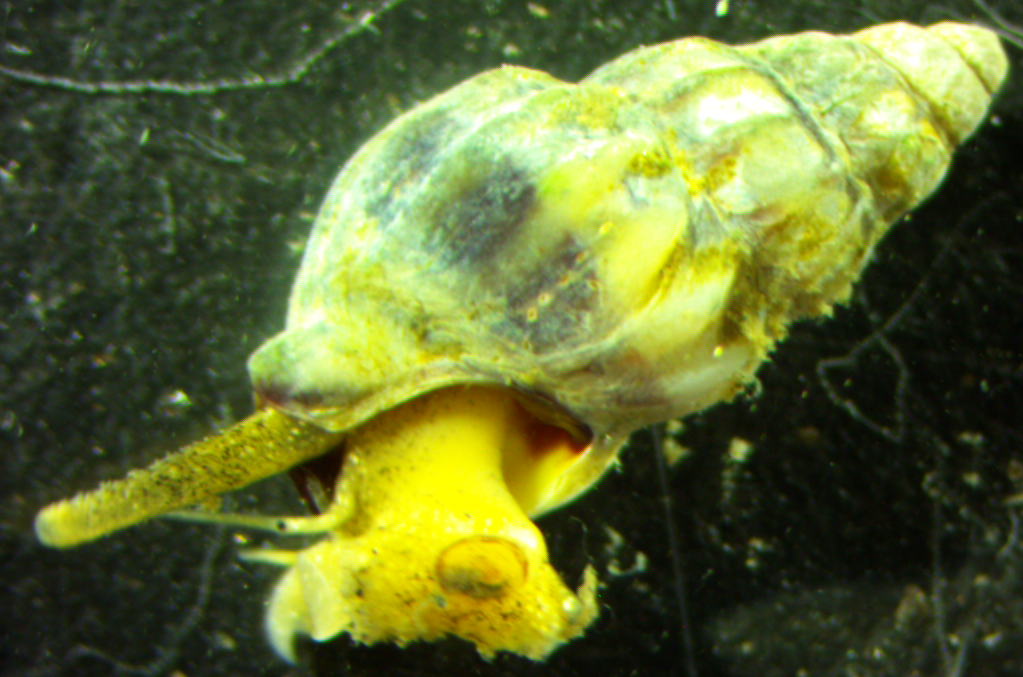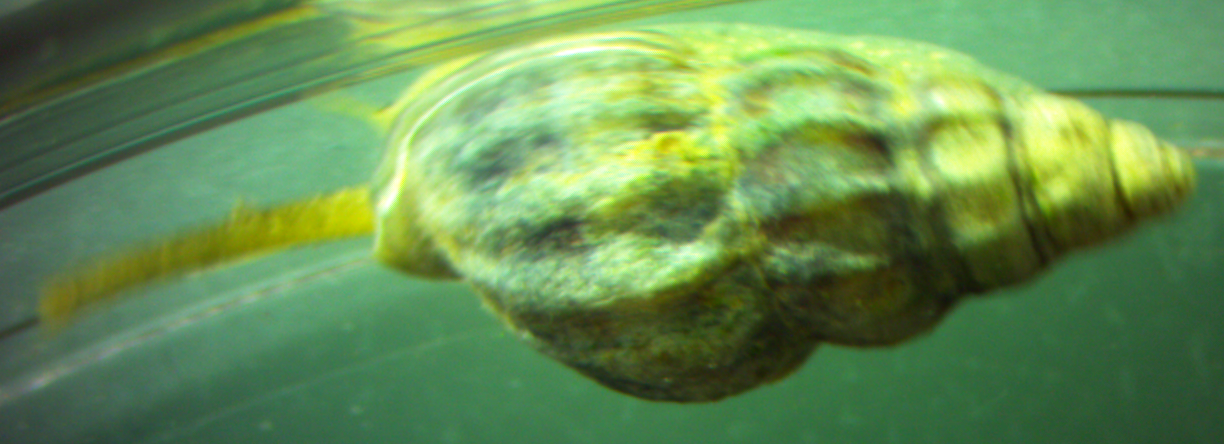Nassarius fraterculus (Bruguiere, 1789)Common name(s): Japanese nassa |
|
| Synonyms: Hima fratercula, Nassa (Hima) fraterculus, Nassa hypolina, Nassa nodosa, Nassa semiplicata hiradoensis, Nassa semiplicata hizenensis, Tritia fratercula |  |
|
Class Gastropoda
Order Neogastropoda
Suborder Rachiglossa
|
|
| Nassarius fraterculus, shell length 12 mm, found on mud flats along the eastern side of Padilla Bay. Note the yellowish foot and siphon, the round, horny operculum embedded in the foot, and the white tentacles with black eyespots. | |
| (Photo by: Dave Cowles, June 2022) | |
Description: As with all members of family Nassariidae (Dogwhelks or nassa mud snails), the coiled shell has a well-developed spire and a siphonal notch or canal but no anal notch (though this species has a narrow posterior notch near where the anal notch would be found). The outer shell is not highly polished and is usually sculptured. The widest part of the aperture is less than half the diameter of the shell. Has a horny operculum. The lowermost portion of the body whorl, including the siphonal canal, is set off from the rest of the shell by a deep groove and upturned for most species in the family (see photos above and below). The anterior end of the Nassarius fraterculus shell is reflexed, with a groove separating the anterior end of the shell from the rest of the shell. It has 6-7 prominent, rounded whorls with 16 prominent axial ribs but the spiral ridges are small and mostly restricted to near the anterior end of the body whorl behind the groove. The oval aperture is about 1/3 the shell length. The inner lip of the aperture is narrow with a sharp edge. The umbilicus is open and wide. The outer lip of the aperture is thick and has three teeth set back within the aperture. The shell is gray, brown, or nearly black with a white or yellowish spiral stripe around the first whorl. Length (height) to 1.5 cm. Note on thisindividual the body is yellow or white, with a very long, extended siphon and pinpoint black eyes on long tentacles. The foot and siphon have a yellow or orange tinge.
How to Distinguish from Similar Species: Illyanassa obsoleta does not have the deep groove at the anterior end of the body whorl. Hima mendica has well-developed spiral ridges along with the axial ribs. Its outer color is often dark brown and the interior of the shell is white. Several Nassarius species have more than 20 axial ribs which are about the same size as the spiral ridges.
Geographical Range: This species is an introduced species from Japan, that arrived in northern Puget Sound on oysters from Japan. Natural range: Sakhalin and Kuril Islands south to Japan and Korea in the northwest Pacific.
Depth Range: Intertidal and subtidal
Habitat: Sand, gravel, rocks.We found this one on mud with scattered rocks. It can survive in marine or brackish water. Its natural range also spans a wide range of temperature from arctic to nearly tropical.
Biology/Natural
History: These
roving scavenger or diatom-eating snails have a very long siphon. Hermit
crabs often inhabit their shells after the snail dies. On muddy
bottoms it pushes its way through the sediment with its long siphon
extended upwards into the water.
It lays eggs in capsules attached to algae (Golikov et al.
1964).
| Return to: | |||
| Main Page | Alphabetic Index | Systematic Index | Glossary |
References:
Dichotomous Keys:Carlton, 2007
Kozloff, 1987, 1996
Scientific Articles:
Web sites:
General Notes and Observations: Locations, abundances, unusual behaviors:

In this photo the indificual crawls rapidly along the side of the petri
dish with its siphon
extended, searching for food. Photo by Dave Cowles, June 2022.
Authors and Editors
of Page:
Dave Cowles (2022): Created original page
CSS coding for page developed by Jonathan Cowles
Salish Sea Invertebrates web site provided courtesy of Walla
Walla University